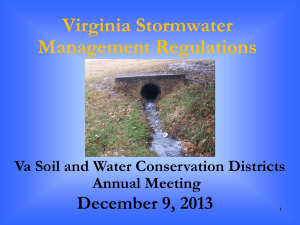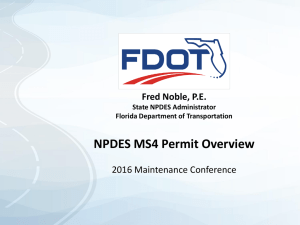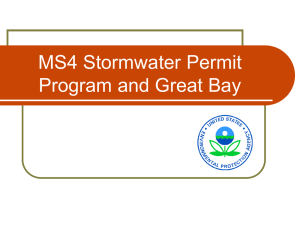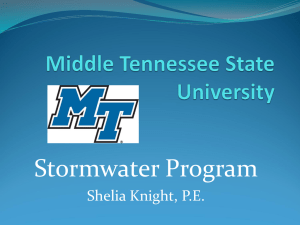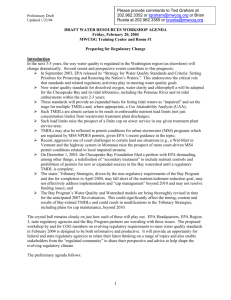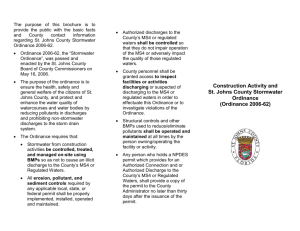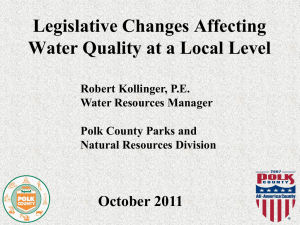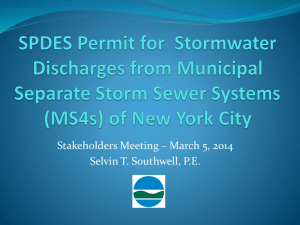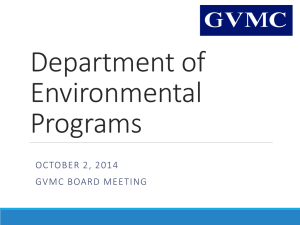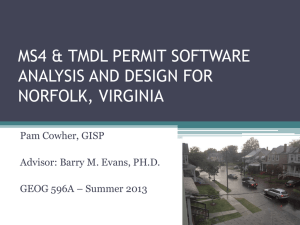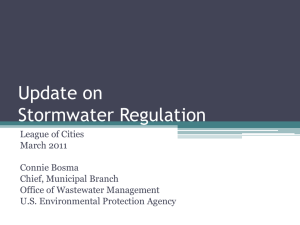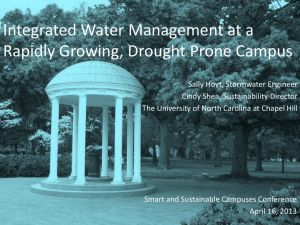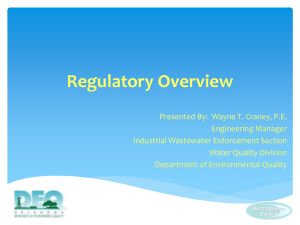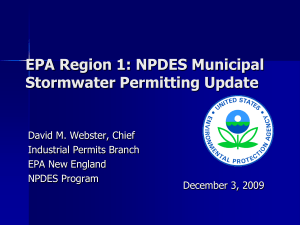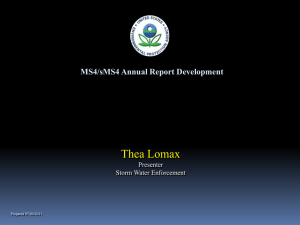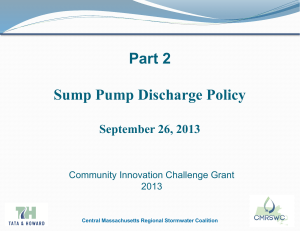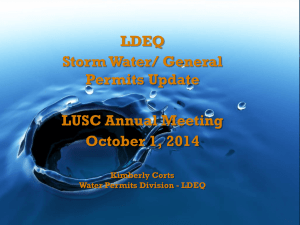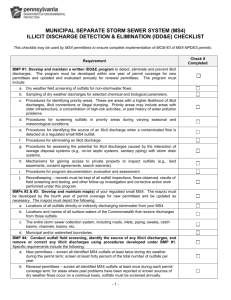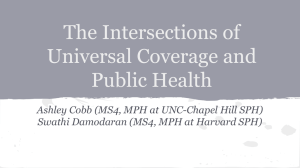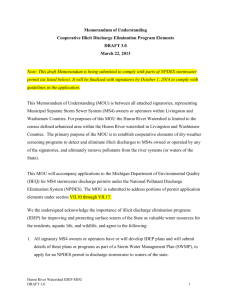EPA Stormwater & Water Regulations
advertisement
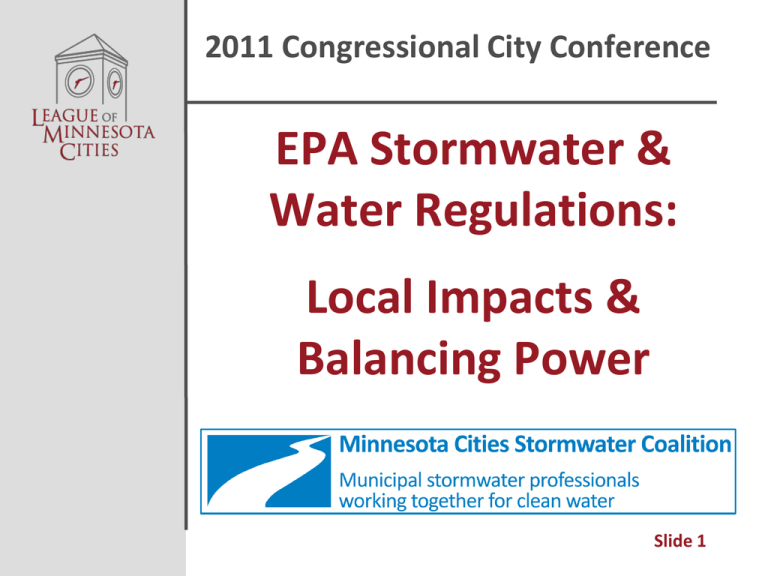
2011 Congressional City Conference EPA Stormwater & Water Regulations: Local Impacts & Balancing Power Slide 1 Who am I? Randy Neprash, P.E. Slide # 2 Basic Concepts #1 Stormwater pollution and water quality are legitimate and important issues for cities Slide #3 Basic Concepts #2 Writing good regulations is very, very hard to do Regulations are always clumsy We are still learning about stormwater and water quality Very few regulators understand how cities function This means they need our assistance Regs should be meaningful & manageable Slide #4 Delegated Permit Authority Slide #5 Local Impacts – types of regs TMDLs Total Maximum Daily Load NPDES permits Wastewater Construction sites Industrial facilities MS4 Municipal Separate Storm Sewer Systems Slide #6 TMDLs Waste Load Allocations are linked to NPDES permits – legal liabilities for MS4 cities Achievability is not the highest priority It’s the receiving water and “science” that count The TMDL must result in meeting the WQ standard Some WLAs have very large load reductions Slide #7 TMDLs Reasonable Assurance for MS4s is very weak Typical “boilerplate” language in Minnesota “Under the MS4 program, each permitted community must develop a Storm Water Pollution Prevention Program, or SWPPP, that lays out the ways in which the community will actively and effectively manage its stormwater. SWPPPs are required to incorporate the results of any approved TMDLs within their area of jurisdiction, subject to review by the MPCA.” Slide #8 TMDLs Inexorable logic WLA reductions are enforced through permits LA reductions are voluntary Incentive money will go to LA sources Permits will get more stringent for MS4 cities Slide #9 MS4 Permitting Program NPDES permits for urban stormwater runoff EPA rules – 1990, 1999, now 761 Phase I MS4s 5,862 Phase II MS4s – 5,182 MS4 cities Slide #10 MS4 Permitting Program Six Minimum Control Measures Public Education & Outreach Public Participation Illicit Discharge Detection & Elimination Construction Site Runoff Control Post-Construction Stormwater Management Pollution Prevention/Municipal Good Housekeeping Slide #11 MS4 Permitting Program 140 employees 11 departments 9 external partners Slide #12 MS4 Permitting Program Slide #13 MS4 Permitting Program Slide #14 MS4 Permitting Program Slide #15 MS4 Permitting Program MCMs #1 & 2 - $101,385 MCM #3 - $131,500 MCM #4 - $174,840 MCM #5 - $236,118 MCM #6 - $839,200 Admin & Asset Depreciation - $1,697,600 Total - $3,180,643 Does not include cost to city construction projects Slide #16 City Participation in the Regulatory Process Driven by local impacts Meaningful participation Develop our own guidance materials Genuine partner with state agency – MPCA Be involved in water quality & stormwater stakeholder groups Influence policy, legislation, and regulations Communicate among cities – share materials Slide #17 Challenges Multiple aspects of “meaningful participation” Policy Politics Technical – water resources engineering Implementation experience Beyond the capacity of any individual cities Very difficult if many individuals are doing separate activities Slide #18 Challenges Genuine partnership with state agency Know the staff Know internal protocols Know the agency’s intent Know the legal aspects – Federal and state Know the politics – at the Legislature Make use of administrative functions Formal comments, contested case hearing petitions Balance of power Slide #19 We formed the MCSC Minnesota Cities Stormwater Coalition Membership of 87 cities of 162 MS4 cities Affiliated with the League of Minnesota Cities Fiscal administration Political & policy alliance Technical consultant – 80 hours per month Slide #20 MCSC Minnesota Cities Stormwater Coalition 11-member Steering Committee Meets monthly Annual budget = $85,000 Annual membership fee Annual membership meeting Slide #21 MCSC – Annual Fee Schedule Population Range Annual Fee 0 - 3,000 3,001 – 6,000 $375 $470 6,001 – 10,000 $565 10,001 – 20,000 20,001 – 30,000 $690 $875 30,001 – 50,000 50,001 – 100,000 $1,125 $1,625 Saint Paul $4,500 Minneapolis $5,500 Slide #22 MCSC’s Actions Guide Plan Project For Phase II cities – in 2002 Created our own program guidance Consistent format for submittals Contested case hearing petition – 2006 Negotiated significant permit revisions Solution for nondegradation court ruling We generated the strategy to resolve the problem Slide #23 MCSC’s Actions - Current Minimal Impact Design Standards Credit system for the broad range of Best Management Practices Draft MS4 Permit Technical seminars for member cities PAH stormwater pond sediment contamination TMDL guidance for member cities Communication & sharing materials Address challenges with volume control Slide #24 Summary Water quality & stormwater pollution are important issues that have to be addressed by cities The impacts of WQ & SW regs is significant and will increase A coalition of regulated cities is useful for: Coordination Sharing information & materials Balancing power with state agencies Slide #25 Federal Rulemaking Informed by National Research Council report 46 people involved Committee members Advice & input Reviewers 4 from Phase I cities 0 from Phase II cities Out of 5,182 regulated cities Slide #26 Randy Neprash randy.neprash@bonestroo.com 651-604-4703 Slide #27
